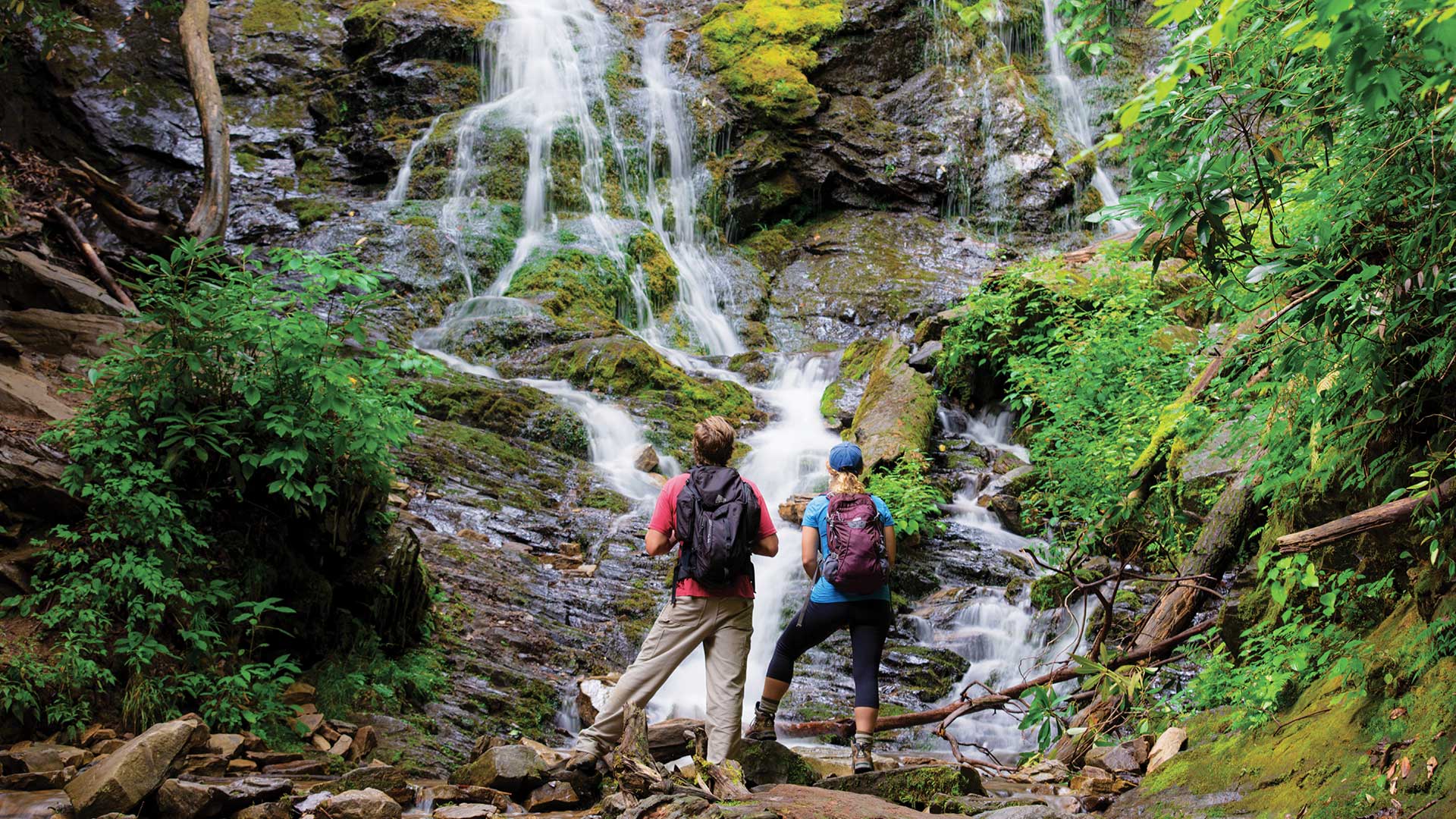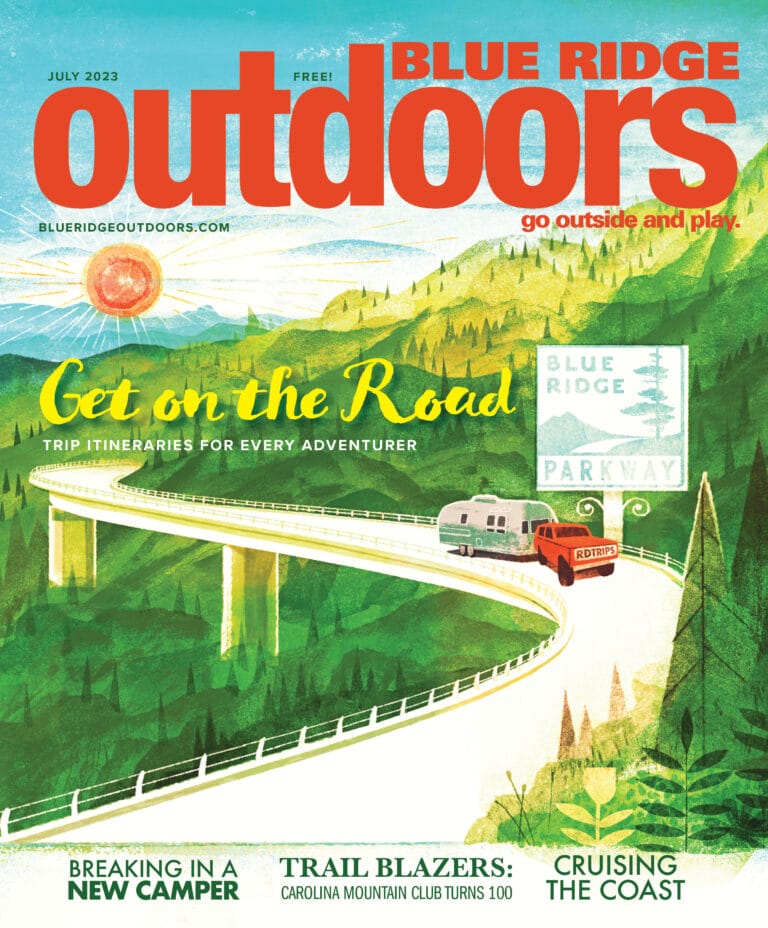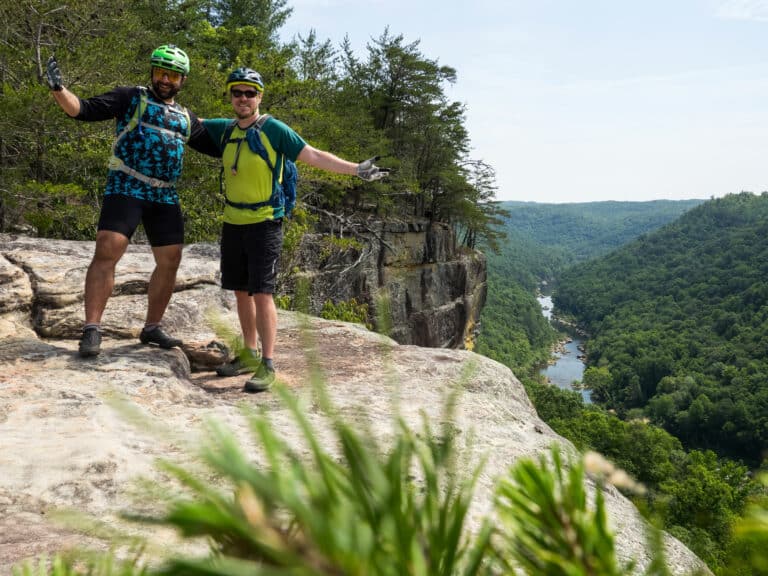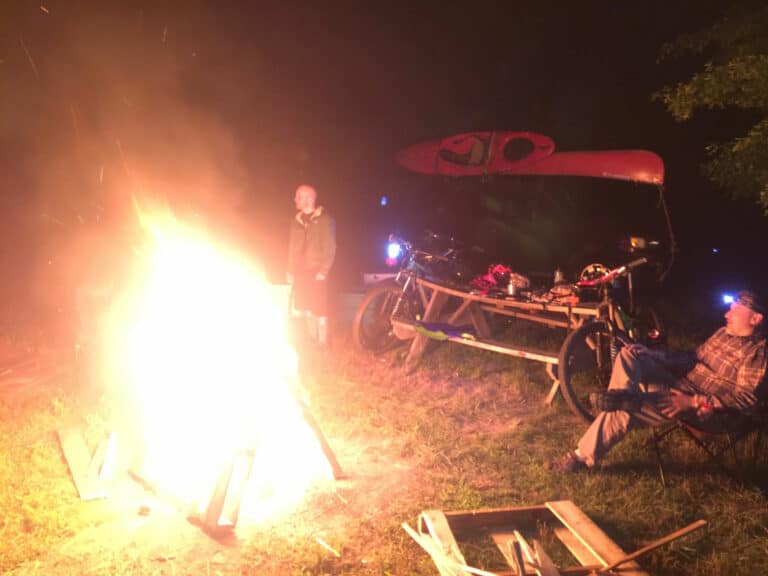Cherokee, North Carolina, may very well be the next best mountain town, and you can thank Harrah’s Cherokee Casino for that.
Harrah’s Cherokee Casino never sleeps
The 150,000-square-foot gaming venue is open 24 hours a day, seven days a week. When I wander in on an early Tuesday evening, there are already hundreds of people crowded around blackjack tables and posted up at the slots. I can’t decide if I’m overwhelmed or impressed.
More than 1,000 machines are spread neatly beneath lighted glass structures that stretch from floor to ceiling. A two-story curtain of water falls from somewhere up above. Carpet cleaner and cigarette smoke hang heavy in the air. Waiters move through the crowds with trays full of drinks.
As I weave in and out of the rows of machines beneath shifting shades of purple light, it becomes apparent that, at 27, I’m the youngest guest at the casino this evening. I’ve only been to a casino once before, so with little idea of where, or how, to start, I grab dinner instead.
The Noodle Bar is packed. I find a lone seat at the bar between two couples, one of which promptly leaves. I order a glass of wine and an overpriced plate of lo mein drenched in soy sauce, feeling every bit a fish out of water, when an older gentleman takes a seat beside me.
“I’ll have what she’s having,” he tells the waitress. “That looks light. I’m trying to watch my sodium.”
He tells me his name is John Smith—“now you can say you’ve met a real-life one”—and he’s been driving from Knoxville, Tenn., to Harrah’s nearly every month since the casino opened back in 1995. There’s a youthful charm about him, despite the silver shock of hair that hangs low over his brow. He says his game of choice is blackjack, but the slot machines are fun, too.
John doesn’t know much about Cherokee outside the walls of the casino. He never stays the night, even though the casino would comp his room (if that’s any indication of how often he frequents Harrah’s), and he only comes to town for the gaming. When I ask about his winningest trip to the casino, he gives me a blank stare.
“Oh, I’ve never won anything. If I walk outta here only having lost $100, $150 bucks, that’s a pretty good night.”
I down the rest of my drink to keep my jaw from hitting the floor. If I’ve done my shell-shocked math correctly, Mr. Smith has lost the equivalent of a year’s entry-level salary here.
“Come on, I’ll show you around.”
He leads me to a row of Game of Thrones-themed slot machines. After watching my $5 bet whittle away to nothing, it’s clear I don’t have the stomach for the gaming life. No matter. The casino is doing just fine without me.
Last year, Harrah’s Cherokee Casino brought in over $300 million. The Harrah’s Cherokee location in particular has been the chain’s most profitable casino for over a decade, even before the 2009 referendum that allowed the casino to serve alcohol. That’s largely due to the fact that there are no Vegas-style casinos like Harrah’s Cherokee in the neighboring states of South Carolina, Georgia, Tennessee, and Virginia.
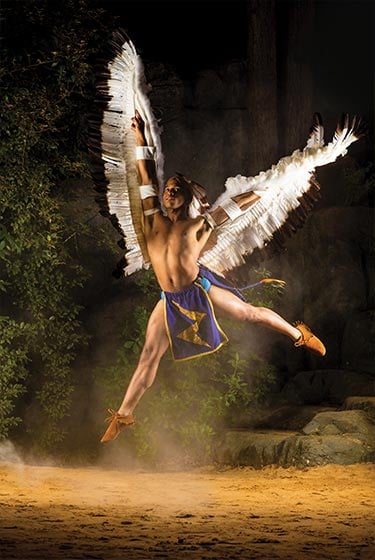
Initially, some of the 13,000-plus enrolled members of the Eastern Band of Cherokee who live on or near the Qualla Boundary were skeptical if not downright opposed to introducing gaming to the community. At the time, unemployment was at an all-time high. Drugs and crime were already rampant in the neighborhood, and tribal members worried that the presence of a casino would bring more organized crime to town.
Then there was the issue of how to handle such a large influx of money. Many feared political corruption would sweep through the ranks of tribal leadership. Indeed, a few corruption scandals have plagued previous tribal chiefs.
And yet, for all of the political challenges that have come as a direct or indirect result of the casino, it’s hard to ignore the benefits. Per the compact agreement decided by the state of North Carolina and Tribal Council, Harrah’s takes only three percent of its annual earnings. Half of the remaining amount is used for funding tribal programs, providing healthcare for every enrolled member, and covering the cost of college for each of its youth. The other half goes right back to Cherokee members in the form of twice-yearly per capita checks.
When the casino first opened, those checks didn’t amount to much. Still, for a seasonal tourist town with a high percentage of families living below the poverty line, it was something. Secretary of Agriculture and Natural Resources Joey Owle remembers the first “per cap” check his family received back in 1996.
“It was $595. I remember it was the first time I ever remember seeing a one hundred dollar bill,” says Owle. “That improved a lot of lives around here.”
Now, 20 years later, Cherokee families are making as much as $12,000 a year from those per cap distributions. It’s not enough to rely on solely—16.2% of Swain County residents still live below the poverty line, which is 3.5% higher than the national average—but according to a longitudinal study conducted by Duke University, the added income is having extraordinary effects on the overall mental and physical wellbeing of Cherokee’s youth.
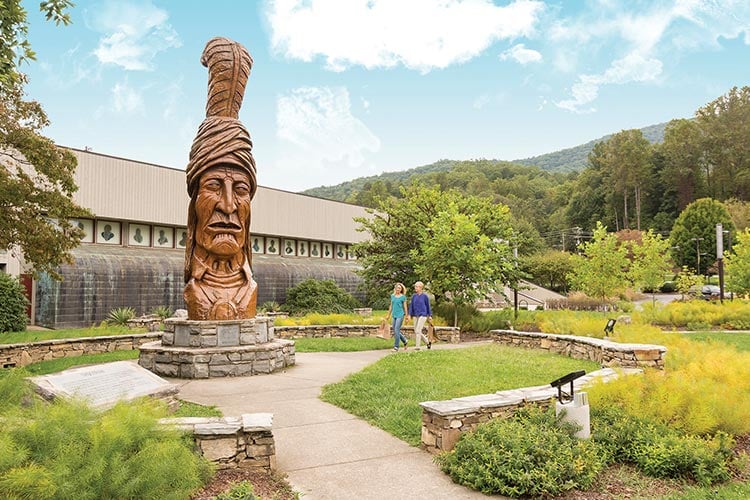
“The boost to the economy has such a ripple effect throughout the entire community,” says Cherokee Indian Hospital CEO Casey Cooper. “The tribe as a municipality not only has so many more resources now but the lives of individuals in my opinion are much improved because people have money, and because people have money, they have the ability to take care of those basic level needs at the bottom of Maslow’s hierarchy.”
The hospital over which Cooper presides is one of the many examples of gaming money being channeled back into the Cherokee community in a big way. Casino funds helped build the $82 million facility, paid for a new $26 million wastewater treatment plant, covered the multimillion dollar cost of building a LEAD-certified k-12 school, and last year, paid for the boundary’s first open-to-the-public trail system at Fire Mountain.
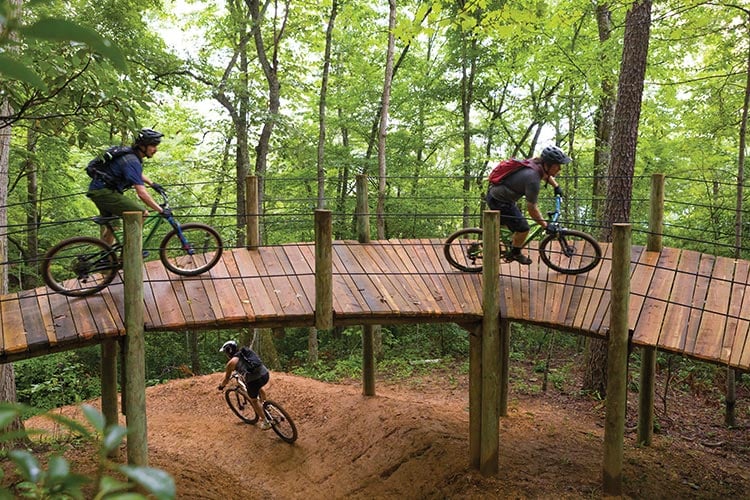
Cherokee’s Outdoor Recreation Economy
The trailhead to the 10.5-mile Fire Mountain trail system is tucked up on the hillside overlooking the Oconaluftee Indian Village. Opened just last summer in June of 2017, the trails look like they could have been cut in last week—even the trail kiosk still smells of fresh-cut wood and paint.
The project, spearheaded by Tonya “Tinker” Jenks with the Cherokee Preservation Foundation, and Jeremy Hyatt, Secretary of Administration, took six years to bring from idea to fruition. Historically, the Cherokee have always catered to tourists—the outdoor drama “Unto These Hills,” which has been around since 1950, has long brought visitors to the Qualla Boundary—but the idea of focusing on something like mountain biking as an economic driver is altogether new to Cherokee.
“When you’re not a gaming tribe, you have to be a resource tribe, but we have the best of both worlds,” says Joey Owle. “We could be doing a better job of managing our forests, and that’s where we’re getting to is looking at that vision of what we have, conserving it, preserving it, and making money off of it as well.”
Owle is tall and slender with quarter-size gauges in both of his ears. He’s sharp, a quick talker who sometimes spills out so much information in one sentence that it’s hard to keep up. At 29 years old, Owle is one of the many Cherokee millennials who took that opportunity to receive a free college education, lived off of the boundary for a few years, but then came home to serve his tribe.
As a kid, Owle used the footpaths and game trails here to get to his friends’ houses on other parts of the boundary. Cherokee still maintains those six communities—Big Cove, Birdtown, Paintown, Wolftown, Yellowhill, and Snowbird, which is located nearby in Graham County—but things are different now. The trails are largely overgrown, parents are less apt to let their children roam free, and once-large tracts of property have become fractionalized.
“When you look at making a trail system now, you may be cutting across 30 or 40 different possessory holders’ lands, and that’s somebody’s private property. That’s trespassing,”
That’s also one of the challenges of expanding any trail opportunities for the public, says Eastern Band of Cherokee Indians Natural Resources Manager Mike LaVoie. If the tribe doesn’t have a large enough tract of land within the boundary, it would have to arrange for land easements from possessory holders or purchase the property outright. It’s not impossible, he says, but there’s a long way to go.
Energy has already been building around the Fire Mountain trails. Later this month, the trail system will play host to the inaugural women’s only Dirty Maiden Enduro Series. It’ll be another few years before the full economic impact of the trail system can be realized, but if the tribe’s fishing tourism is any indication of the potential success, the future is looking good.
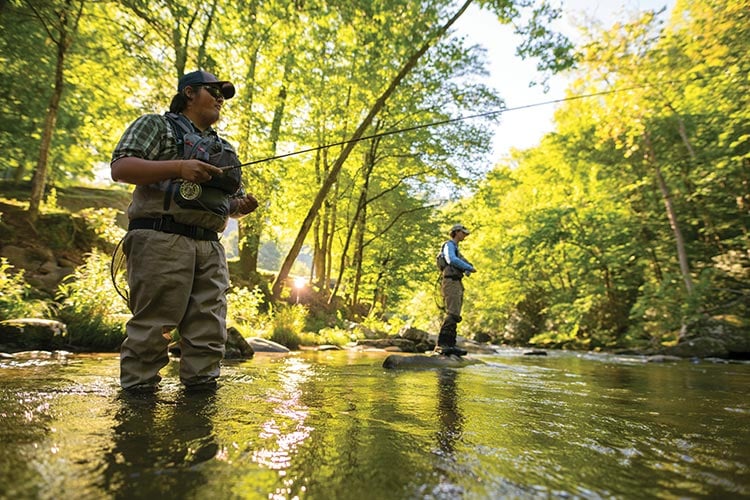
Launched back in the 1960s by what was then the U.S. Bureau of Fisheries (now U.S. Fish and Wildlife Service), Cherokee’s trout program brings almost 50,000 anglers annually to the boundary. The program stocks more than 230,000 pounds of fish every year, which anglers can get a taste of for as little as $10 per day.
Four years ago, the Natural Resources Department conducted an economic impact study on the fishing program and found that anglers brought in an average of $26 million annually, which makes trout fishing the second largest revenue generator for the Eastern Band of Cherokee after Harrah’s casino. Fishing tourism additionally supported upwards of 300 part-time and full-time jobs.
“The fishing program has been a really great boon to tourism,” says LaVoie. “Fish and trout in general have been very important to Cherokee history and culture for centuries, but also economically to the tribe today. There’s a multiplier effect of eight for every dollar spent by folks who come here to fish.”
With pristine headwaters protected by the Blue Ridge Parkway and Great Smoky Mountains National Park, the Cherokee may very well have one of the best trout fisheries in the region. Over 30 miles of tribal waters are stocked on the boundary, with over 60 miles of headwater streams available to enrolled members only. The tribe also hosts annual casting tournaments like the Rumble in the Rhododendron, Casting for Hope, and the Talking Trees Children’s Trout Derby.
“I grew up fishing here in the Big Cove community,” says Fly Fish Cherokee owner and guide Michael Bradley. “I’ve been fishing forever. It’s great because you can fish all year here. I’ve caught a few fish that are 28 inches.”
Bradley is only 27 years old, an enrolled member, and a man of very few words, but he’s making a big name not only for himself but for the entire Cherokee community. Bradley’s held a top 10 spot on Fly Fishing Team USA for the past year and a half and has traveled all over the country to compete in national events. When he’s not competing or organizing local fishing tournaments, he’s commercially guiding clients on Cherokee waters 300 days out of the year.

Beer and Bike Shops
It’s relevant businesses like Bradley’s fly fishing outfitter that Owle hopes to see more of in the years to come. Cherokee is arguably already ahead of the game compared to many parts of rural Appalachia looking to adopt an outdoor economy—the tribe retains its younger population, has a few key employers, offers ample lodging and restaurants (albeit fast food chains) and cultural activities, and sits right at the gateway to Great Smoky Mountains National Park and the Blue Ridge Parkway. What the tribe really needs, says Owle, is to allow the sale of alcohol on the boundary.
“As a young person, I want the opportunity to go to a local brewery or to go to a good restaurant and get a good beer,” he says. “What we have is this older generation which, I understand, believes alcohol has had a tremendously negative impact on native communities. Well, that’s true for a lot of places, not just native communities.”
“We don’t charge anything to use our trails, so people all over the Southeast are hearing about our amazing trail system, they’re coming here, they’re riding it, and then they’re going to Bryson City to have a beer,” says Principal Chief Richard Sneed. “We’re going to have to have alcohol sales. We’ve got to keep them here to spend their money.”
This year, the tribe will vote on an alcohol referendum. Both Owle and Chief Sneed agree that there seems to be a growing acceptance of alcohol among tribal members, even those who are personally opposed to drinking. Given the community’s proximity to Beer City, U.S.A., aka Asheville, N.C., the tribe’s adoption of alcohol is only a matter of time.
Until then, Cherokee has plenty to celebrate. Next month, Motion Makers Bicycle Shop and Outdoor 76 will open the first outdoor outfitter on the boundary. The joint establishment, which will be located in a yellow house at the edge of town, will feature an open design with Motion Makers on the first floor and Outdoor 76 on the second floor.
For Motion Makers owner Kent Crandall, the partnership is the perfect fit. Crandall says he had always wanted to open up a location in Cherokee, but hadn’t been actively pursuing it until the daughter of a landlord reached out to him specifically because her father wanted an outdoor business in his retail space.
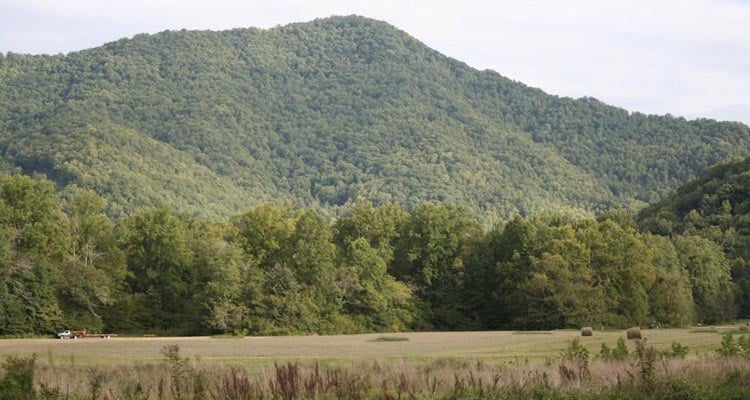
“We knew this would be a real opportunity,” says Cranford. “Our shop is right at the beginning, literally, of the Oconaluftee River Trail. There’s already a community of people here who we know are getting more active and already utilizing our Sylva store as their access point for bikes. To have the opportunity to come into a community that is clearly opening its arms to the outdoors but doesn’t have all of the resources, it’s an opportunity I couldn’t pass up.”
The Cherokee location of Motion Makers will be the store’s third site and will offer the company’s largest rental fleet yet, including cruisers, mountain bikes, and even e-bikes, which are allowed on Fire Mountain’s trails. It certainly feels like fortuitous timing, for Cherokee, for Cranford, and for Outdoor 76 co-owners Cory McCall and Rob Gasbarro.
“It’s an untapped market,” says McCall. “There are 12 million people a year visiting the Smokies. As a whole, we want to service those people visiting, but also the community of Cherokee. We love our town of Franklin to death, but we’re excited to open another location and gain the trust of this new community. Community involvement is ingrained in our business, and we want to be able to translate that here.”
Finally, it seems Cherokee is opening its eyes to the golden egg it’s been sitting on for hundreds of years. While the casino has certainly helped put Cherokee on the map, El Camino Motel owner Lambert Wilson is grateful to see the tribe’s priorities shifting.
“Gambling is so lucrative and they make so much money, but the tribe has realized that you can’t put your eggs in one basket. You’ve got to diversify.”
